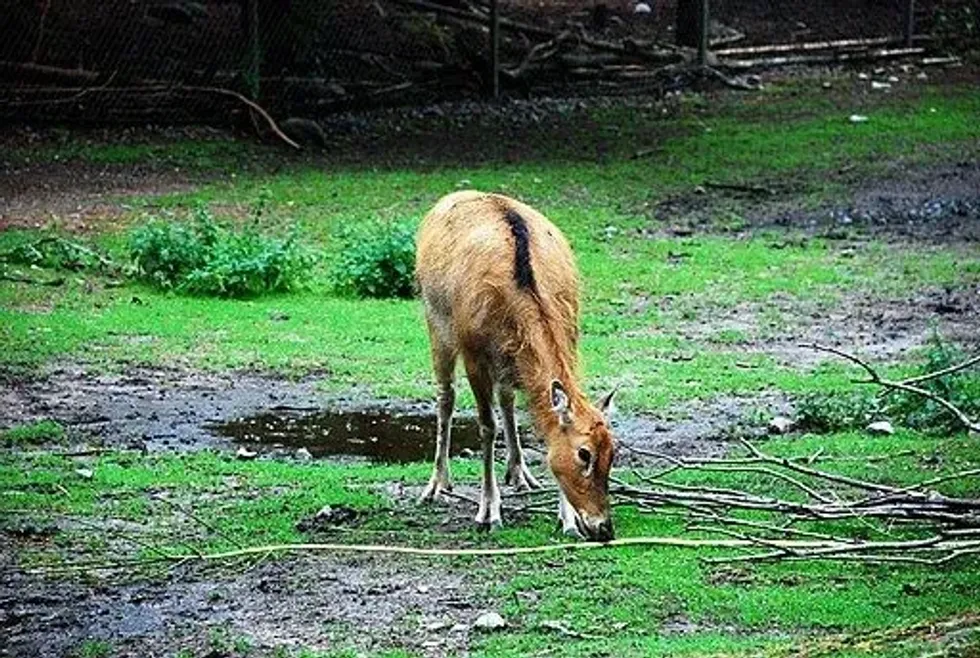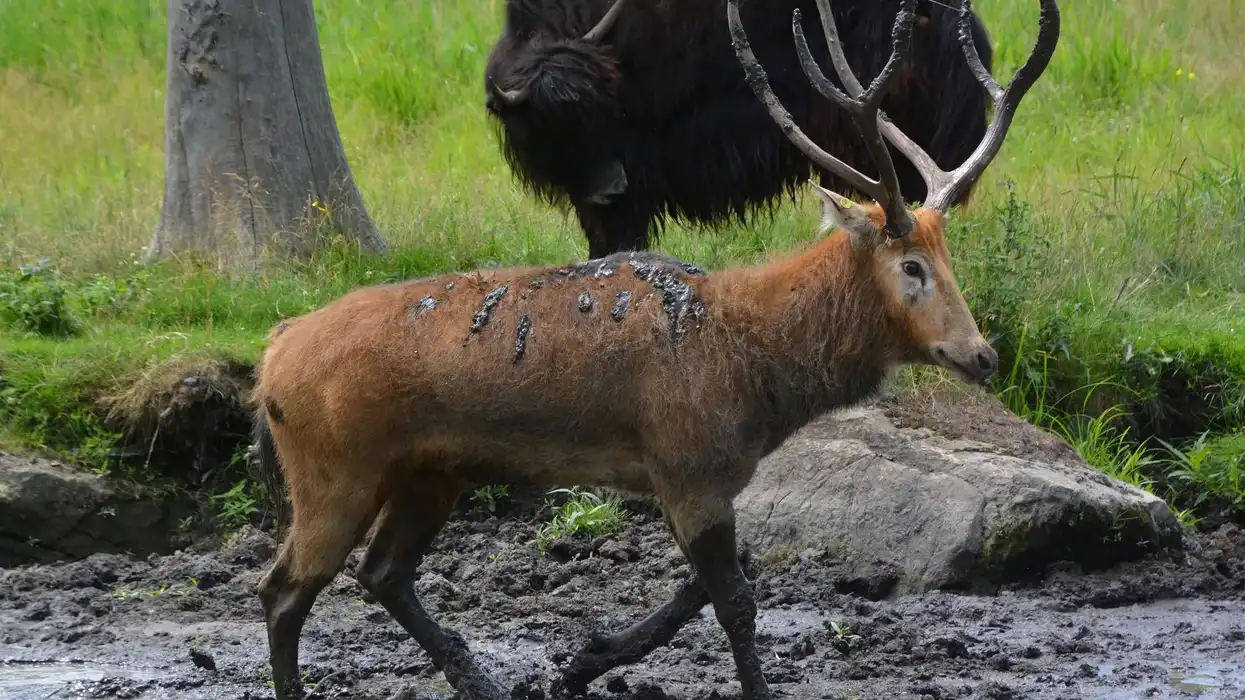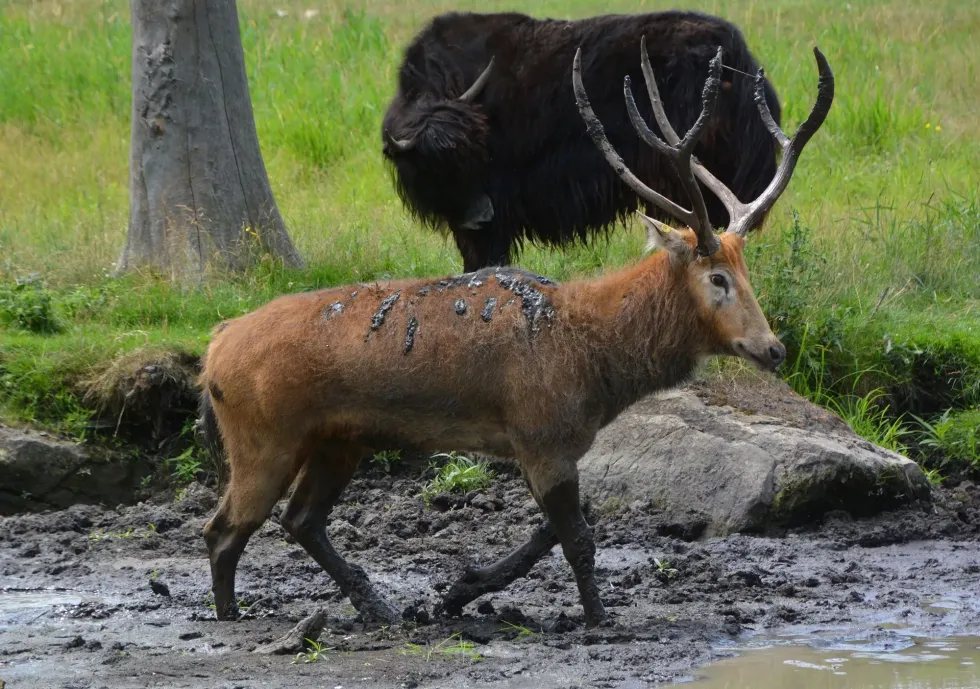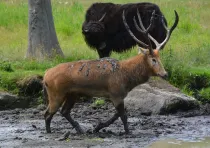Fun Pere David's Deer Facts For Kids

Père David's deer, also spelled Pere David’s deer, Elaphurus davidianus (scientific name), is known as ‘milu’ or ‘sibuxiang’ in China. This deer is native to China and used to exist all through the country. Gradually, the Pere David’s deer evolved to live in the swamps and marshlands.
Père David's deer (Elaphurus davidianus) were hunted for their meat, and their habitats were threatened as people starting reclaiming marshlands to build homes for themselves. Eventually, only one herd was left, and this was carefully protected in the imperial hunting park at the palace of the Emperor of China.
A French missionary, Armand David, was allowed to see the herd and preserve specimens, which he took back to Europe.
Later a small population of these deer was kept safely in zoos throughout Europe. This was lucky because the last remaining herd of Père David's deer drowned in a flood at the Emperor’s palace were eaten by starving peasants, or were killed in the Boxer Rebellion.
These wild animals were now completely extinct in China.
In the 19th century, the population of Pere David’s deer was allowed to grow under the care of the 11th Duke of Bedford, the UK at his estate at Woburn Abbey. Thanks to the success of the reintroduction program Pere David’s deer returned to their native China.
By the end of this article, you will have knowledge on Pere David's deer information like Pere David's deer size, Pere David's deer shoulder height, Pere David's deer skeleton, Pere David's deer rut, Pere David's deer WWF status, Pere David's deer sexual maturity, and Pere David's deer population.
You may also check out the fact files on wild boar and Tasmanian tigers from Kidadl.
Pere David's Deer Interesting Facts
What type of animal is a Pere David's deer?
The Pere Davids’ deer (Elaphurus davidianus) is a very rare type of deer that is native to the wetlands of China. They have shaggy fur that changes color from reddish-brown to grayish in the winter. While they are extinct in the wild, small populations still live in national parks and zoos.
What class of animal does a Pere David's deer belong to?
Pere David’s deer or Père David's deer belongs to class Mammalia, and like all mammals, the female animals provide milk to their babies till they grow up. Other members of the Cervidae family include Axis deer and black-tailed deer.
How many Pere David's deers are there in the world?
Pere David’s deer (Elaphurus davidianusis) is a species that was hunted to extinction and no longer lives in the wild. The remaining population of deer can be found in national parks in their native lands of China, and zoos in Europe and around the world.
Though there is no confirmed number, it is estimated that the total population of Pere David’s deer today is around 2000 individuals.
Where does a Pere David's deer live?
While these deer belong to the wetlands, today, the Pere David's deer range population is scattered through zoos and sanctuaries around the world. In the national parks today, these deer live in marshy areas, where their webbed hooves with wide spaces allow them to move easily through the water.
What is a Pere David's deer's habitat?
The traditional habitat of the Père David's deer is the swamps, reed-filled marshes, and wetlands of their native Southern China. They are well adapted to living in the region, with webbed feet and spread hooves that allow them to move easily in the water.
Even their shaggy fur helps protect them from the water in their habitat. The males also use the mud, reeds and other aquatic plants to decorate their antlers!
Who do Pere David's deers live with?
Père David's deer tend to live in large groups, just like other deer species. They are very social and tend to stick together in a group before and after the mating season.
Then, the males move out of their herds to find their harems of females. The females of the Pere David’s deer stay together in herds or packs throughout the year for their entire life.
How long does a Pere David's deer live?
On average, Pere Davids deer tend to live anywhere between 18 to 20 years, which is more than the average lifespans of most deer species. Particularly long-lived Père David's deer have lived up to 23 years!
How do they reproduce?
Female Pere David’s Deer reach sexual maturity a year earlier than the males, which is when they are around two years old. Once the males mature, they leave their herds, only to return for the breeding season, and after they are done eating after their long fast.
During the breeding season, around June, the Père David's deer male animal fights with others in the group for the right to breed.
The winning animal stays with the herding group, mating with the females and defending his harem for the entirety of the breeding season. During this time, they lose a lot of weight because they don’t eat at all.
After the season is over, the Père David's deer males leave the herding group again for few months to feed and regain their weight. The females give birth to the babies after a gestation period of 280 days. Usually, only one baby is born per female because they are comparatively large. Rarely, the Pere David’s deer may have twins.
What is their conservation status?
The IUCN (International Union for Conservation of Nature) has included the Pere David’s deer in its Red List of threatened species. Their conservation status is EW which is Extinct in the Wild.
Originally from China, the Père David's deer species were hunted to extinction. Its unusual features led to many stories being told about the deer, which led people to see the Pere David's deer Milu as a symbol of good fortune.
It was believed that the meat of these deer would grant them everlasting life. Between this and the loss of their habitat, only one herd of deer were left in China, in the imperial hunting park of the then Emperor of China.
From there, the French missionary Armand David took a few to Europe, where the Père David's deer species survived. In China, the last Père David's deer herd was drowned, eaten by starving peasants, or killed in the Boxer Rebellion.
By the 1900s, the Pere David's deer was extinct in the wild.
Today, they have been reintroduced to China from a breeding population that was cared for by the Duke of Bedford, the UK at his estate at Woburn Abbey in the 19th century. The Père David's deer numbers are increasing, but the pace remains low because of threats to their habitats, hunting, and their gestation period.
Pere David's Deer Fun Facts
What do Pere David's deers look like?

Pere David’s deer are very unusual looking. Informally, the Chinese people call them ‘sibuxiang,’ which means ‘like none of the four’ because the deer was said to have the features of four different animals.
They have shaggy fur to help them live in their wet, marshy habitats. It is usually reddish brown in the summer and loses color to become grayish in the winter to allow them to blend into its environment. Both males and females have a black line running down their spine and in their tails.
These tails are slightly longer than that of the average deer. The males also have a mane around their neck.
The Pere David's deer has antlers that are light brown – they look and feel like wood. The branches of these antlers face backward, which is very unusual. They have long necks and legs, and large eyes. They have webbed feet and spread hooves which lets them move easily in the marshlands that are their home.
How cute are they?
The hunting of Pere David’s deer was not for their fur or their features. Instead, they were hunted for their meat.
Père David's deer features are unusual, so they would not classify as one of the cuter deer species. The Chinese people thought that Pere David’s deer Milu had the features of a cow, camel, horse and donkey, with only the antlers of a deer, so it is not very cute.
How do they communicate?
Pere David’s deer communicate with each other by marking their territory with their scent. Oddly, the males of the Pere David's deer will spray themselves with urine during breeding season as well.
During the breeding season, these animals might roar at each other when they fight. Mostly, deer tend to be fairly quiet animals, relying on their body language and scents to talk to each other.
How big is a Pere David's deer?
Pere David’s deer males tend to be twice the size of most deer species in America, as the fallow deer. These animals are anywhere between 78 - 86 in (198-218cm) and 46.8 in (118 cm) tall.
How fast can a Pere David's deer run?
This species of deer can run up to 18 mph (29 kph)! They have webbed feet and spread hooves. Pronghorns are three times faster than this deer.
How much does a Pere David's deer weigh?
The males of Pere David’s deer tend to be larger than the females. The males can easily reach 441lbs (200 kg), while the females tend to weigh around 298 lb (135 kg).
What are the male and female names of the species?
Male deer are called stags, and female deer are called does, regardless of the species.
What would you call a baby Pere David's deer?
Baby deers are known as fawns.
What do they eat?
The Pere David's deer are herbivores, and they live off different kinds of grasses, leaves, and other vegetation in the area. If the summer has been very dry, they might even eat the aquatic plants growing in the marshes.
Are they friendly?
All deer species tend to be wary of human beings. Since these deer have been raised in captivity, they are slightly friendlier animals. The male Pere Davids deer are more careful, and spook easily, especially if it is close to breeding season. The females are a little friendlier, but neither will approach human beings easily.
Would they make a good pet?
Pere David’s deer are wild animals, live in groups, and are highly endangered, with their population being only around 2,000 individuals in the entire world. They are extinct in the wild. They have been raised in captivity but need a lot of land and resources and their natural habitat to survive. They will not make good pets.
Did you know...
Pere David’s deer can stand on their hind legs and box each other in their fights. They might even bite each other, as they have large canines, which is odd for herbivores. Both male and female Pere Davids Deer fight, but most fights are between the stags during the breeding season.
Because of their strange journeys, there are many hybrids of the Pere David’s deer in the European wilderness. Seeing these, deer farms in New Zealand managed by Europeans began to experiment, and they made a hybrid Pere David’s Deer that was crossed with the red deer.
These hybrid animals were successful and could easily breed with other red deer as well!
What is unique about a Pere David's deer's antlers?
Pere David’s Deer have woody-looking antlers that grow in winter, unlike other deer. More unusually, the main beam points straight up, with the remaining branches pointing backward. Both antlers are also more or less equally sized.
Can Pere David's deers swim?
Yes! Pere David’s deer are animals adapted to move in the water. They have webbed feet and shaggy fur and love going in as deep as their shoulders.
Here at Kidadl, we have carefully created lots of interesting family-friendly animal facts for everyone to discover! Learn more about some other mammals from our zebra facts and reindeer facts page.
You can even occupy yourself at home by coloring in one of our free printable Pere david's deer coloring pages.
We Want Your Photos!
More for You
See All
Bachelor of Arts specializing in English Literature

Akinwalere OlaleyeBachelor of Arts specializing in English Literature
As a highly motivated, detail-oriented, and energetic individual, Olaleye's expertise lies in administrative and management operations. With extensive knowledge as an Editor and Communications Analyst, Olaleye excels in editing, writing, and media relations. Her commitment to upholding professional ethics and driving organizational growth sets her apart. She has a bachelor's degree in English Literature from the University of Benin, Edo State.
Bachelor of Arts specializing in English Literature, Masters of Art specializing in English and Communication Skills

Sonali RawatBachelor of Arts specializing in English Literature, Masters of Art specializing in English and Communication Skills
Sonali has a Bachelor's degree in English literature from Guru Gobind Singh Indraprastha University and is currently pursuing a Master's in English and Communication from Christ University. With considerable experience in writing about lifestyle topics, including travel and health, she has a passion for Japanese culture, especially fashion, and anime, and has written on the subject before. Sonali has event managed a creative-writing festival and coordinated a student magazine at her university. Her favorite authors are Toni Morrison and Anita Desai.
Disclaimer
1) Kidadl is independent and to make our service free to you the reader we are supported by advertising. We hope you love our recommendations for products and services! What we suggest is selected independently by the Kidadl team. If you purchase using the Buy Now button we may earn a small commission. This does not influence our choices. Prices are correct and items are available at the time the article was published but we cannot guarantee that on the time of reading. Please note that Kidadl is a participant in the Amazon Services LLC Associates Program, an affiliate advertising program designed to provide a means for sites to earn advertising fees by advertising and linking to Amazon. We also link to other websites, but are not responsible for their content.
2) At Kidadl, we strive to recommend the very best activities and events. We will always aim to give you accurate information at the date of publication - however, information does change, so it’s important you do your own research, double-check and make the decision that is right for your family. We recognise that not all activities and ideas are appropriate for all children and families or in all circumstances. Our recommended activities are based on age but these are a guide. We recommend that these ideas are used as inspiration, that ideas are undertaken with appropriate adult supervision, and that each adult uses their own discretion and knowledge of their children to consider the safety and suitability. Kidadl cannot accept liability for the execution of these ideas, and parental supervision is advised at all times, as safety is paramount. Anyone using the information provided by Kidadl does so at their own risk and we can not accept liability if things go wrong.
3) Because we are an educational resource, we have quotes and facts about a range of historical and modern figures. We do not endorse the actions of or rhetoric of all the people included in these collections, but we think they are important for growing minds to learn about under the guidance of parents or guardians.







